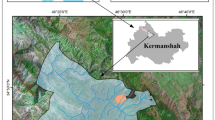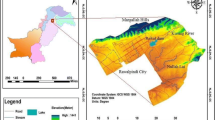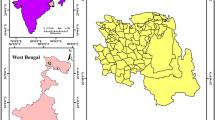Abstract
Urban construction land suitability evaluation (UCLSE) is a complex system engineering and the basis for rational use of the limited urban land resources in China. It has an important practical value on urban construction land use planning and management from the angle of methodology. As a widely used technique, traditional multi-criteria evaluation based on GIS (MCE-GIS), is not suitable for UCLSE. This study develops an improved MCE-GIS method which could be more suitable for UCLSE based on urban complex ecological system theory and the summary of the shortcomings of traditional MCE-GIS. The improvements include three aspects: a composite evaluation index system rather than natural indexes alone, an index weight calculated by using fuzzy Analytic Hierarchy Process (AHP) method rather than the common AHP method, and the integrated overlay rule, which includes selecting the minimum value, weighted linear combination (WLC) and simple summation. The main advantage of this improved technique is that it can make UCLSE more comprehensive, more operational and more reasonable. It can provide a scientific basis for decision making in the planning and management of urban construction land use. The improved MCE-GIS system has been adopted in the New Hefei City, Anhui Province, China. Based on the results of UCLSE in New Hefei, three functional areas including construction-appropriate areas, construction-restricted areas and construction-forbidden areas could be worked out, in which 36.90% of the total study area could be developed as urban construction land and the remaining 63.10% should be protected as reserves land or as ecological land. Furthermore, the results can provide scientific decision support for spatial planning and eco-environment protection in New Hefei.
Similar content being viewed by others
References
Banai R, 1993. Fuzziness in geographic information systems: Contributions from the analytic hierarchy process. International Journal of Geographical Information Systems, 7(4): 315–329. doi: 10.1080/02693799308901964
Brail R, Klosterman R, 2001. Planning Support Systems: Integrating Geographic Information Systems, Models, and Visualization Tools. Redlands: ESRI Press.
Burrough P, McDonnell R A, 1998. Principles of Geographical Information Systems. Oxford: Oxford University Press.
Cao Yongqing, Tang Fanghua, 2005. Systems Engineering and Information Technology of Urban Planning. Beijing: China Railway Publishing House. (in Chinese)
Carver S J, 1991. Integrating multi-criteria evaluation with geographical information systems. International Journal of Geographical Information Systems, 5(3): 321–339. doi: 10.1080/02693799108927858
Chen Gangqiang, Li Xun, Xu Xueqiang, 2008. Spatial agglomeration and evolution of urban population in China. Acta Geographica Sinica, 63(10): 1045–1054. (in Chinese)
Collins M G., Steiner F R, Rushman M J, 2001. Land-use suitability analysis in the United States: historical development and promising technological achievements. Environmental Management, 28(5): 611–621. doi: 10.1007/s002670010247
Fan Jie, Sun Wei, Zhou Kan et al., 2012. Major function oriented zone: New method of spatial regulation for reshaping regional development pattern in China. Chinese Geographical Science, 22(2): 196–209. doi: 10.1007/s11769-012-0528-y
Fisher P, 2000. Fuzzy modeling. In: Openshaw S et al. (eds.). Geo-Computation. London: Taylor and Francis, 161–186.
He Dan, Jin Fengjun, Zhou Jing, 2011. Urban construction land suitability evaluation in resource-based cities: Taking the Grand Canal Ecologic and Economic Area as an example. Geographical Research, 30(4): 655–666. (in Chinese)
Hu Yecui, Liu Yansui, Deng Xusheng, 2004. Relativity analysis on land use and land cover change and optimal allocation of land resources. Progress in Geography, 23(2): 51–57. (in Chinese)
Jankowski P, 1995. Integrating Geographical information system and multi-criteria decision making methods. International Journal of Geographical Information Systems, 9(3): 251–273. doi: 10.1080/02693799508902036
Jiang H, Eastman J R, 2000. Application of fuzzy measures in multi-criteria evaluation in GIS. International Journal of Geographical Information Systems, 14(2): 173–184. doi: 10.1080/136588100240903
Jiang Yifan, Deng Gang, Lu Dongai, 2011. Land suitability assessment in alpine and canyon area based on GIS: a case study of Lancang county of Yunnan Province. Science of Surveying and Mapping, 36(1): 155–157. (in Chinese)
Jin Dongxiao, 2006. Some thoughts over land control. City Planning Review, 30(2): 34–38. (in Chinese)
Joerin F, Theriault M, Musy A, 2001. Using GIS and outranking multi-criteria analysis for land use suitability assessment. International Journal of Geographical Information Systems, 15(2): 153–174. doi: 10.1080/13658810051030487
Krzanowski R, Raper J, 2001. Spatial Evolutionary Modeling. Oxford: Oxford University Press.
Li X, Yeh A G., 2000. Modeling sustainable urban development by the integration of constrained cellular automata and GIS. International Journal of Geographical Information Science, 14(2): 131–152. doi: 10.1080/136588100240886
Li You, Wang Yanglin, Peng Jian et al., 2010. Assessment of urban land suitability for construction in view of landscape ecology: A case study of Dandong city. Acta Ecologica Sinica, 30(8): 2141–2150. (in Chinese)
Li Zhi, Li Guoping, 2008. An empirical study of China’s urban expansion factors. Tongji University Journal (Social Science Section), 19(6): 30–34. (in Chinese)
Ligtenberg A, Bregt A K, Van lammeren R, 2001. Multi- actor-based land use modeling: spatial planning using agents. Landscape and Urban Planning, 56(1): 21–33. doi: http://dx.doi.org/10.1016/S0169-2046(01)00162-1
Malczewski J, 1999. Multi-criteria GIS and Decision Analysis. London: John Wiley and Sons.
Malczewski J, 2004. GIS-based land-use suitability analysis: A critical overview. Progress in Planning, (62): 3–65. doi: 10.1016/j.progress.2003.09.002
McHarg I L, 1969. Design with Nature. New York: Natural History Press.
Openshaw S, Abrahart R J, 2000. Geo-Computation. London: Taylor and Francis.
Pereira J M C, Duckstein L, 1993. A multiple criteria decision-making approach to GIS-based land suitability evaluation. International Journal of Geographical Information Systems, 7(5): 407–424. doi: 10.1080/02693799308901971
Qu Yanbo, Zhang Fengrong, Du Suqin et al., 2010. Assessment method for ecological and economic suitability of urban construction land in Pinggu District, Beijing. China Land Science, 24(12): 21–27. (in Chinese)
Saaty T L, 1980. The Analytic Hierarchy Process. New York: McGraw-Hill.
Statistical Bureau of Anhui, 2011. Anhui Statistical Yearbook. Beijing: China Statistics Press. (in Chinese)
Statistical Bureau of Hefei, 2011. Hefei Statistical Yearbook. Beijing: China Statistics Press. (in Chinese)
Steinitz C, Parker P, Jordan L, 1976. Hand-drawn overlays: Their history and prospective uses. Landscape Architect, 66(5): 444–454.
Stewart T J, Janssen R, van Herwijnen M, 2003. A genetic algorithm approach to multi objective land use planning. Computers and Operations Research, 31(14): 2293–2313. doi: 10.1016/S0305-0548(03)00188-6
Tan Minghong, Lu Changhe, 2005. Urban land expansion and farmland loss in China. Journal of Natural Resources, 20(1): 52–58. (in Chinese)
Thill J C. 1999. Multicriteria Decision-making and Analysis: A Geographic Information Sciences Approach. New York: Ashgate.
Wang Quan, Xu Jiangang, Xu Wenwen, 2005. A GIS approach to the urban land suitability evaluation. Progress in Geophysics, 20(3): 877–880. (in Chinese)
Wang Rusong, Hu Dan, Li Feng et al., 2010. Complex Ecological Management of the Regional Urban Development. Beijing: China Meteorological Press. (in Chinese)
Wang Yan, Song Zhenbai, Wu Peilin, 2008. Land suitability evaluation of high and new technology industry based on BP network. Research of Soil and Water Conservation, 15(4): 248–250. (in Chinese)
Xu Zeshui, 2001. Algorithm for priority of fuzzy complementary judgment matrix. Journal of Systems Engineering, 16(4): 311–314. (in Chinese)
Ye Jiaan, Song Xiaodong, Niu Xinyi et al., 2006. Geographical Information and Planning Support System. Beijing: Science Press. (in Chinese)
Yin Haiwei, Xu Jiangang, Chen Changyong et al., 2006. GIS-based ecological sensitivity analysis in the east of Wujiang city. Scientia Geographica Sinica, 26(1): 64–69. (in Chinese)
Zadeh L A, 1965. Fuzzy sets. Information and Control, 8(3): 338–353. doi: 10.1016/S0019-9958(65)90241-X
Zhang Xiaorui, Zhou Guoyan, 2009. Land suitability evaluation in master plan of development zone. Modern Urban Research, (12): 57–61. (in Chinese)
Zhou J, Civco D L, 1996. Using Genetic learning neural networks for spatial decision making in GIS. Photogram metric Engineering and Remote Sensing, 62(11): 1287–1295. doi: 0099-1112/96/6211-1287
Zong Yueguang, Wang Rong, Wang Chenggang et al., 2007. Ecological suitability assessment on land use based on potential-constrain approach: the case of urbanized areas in Dalian city, China. Geographical Research, 26(6): 1117–1125. (in Chinese)
Zong Yueguang, Zhang Xiaorui, He Jinliao et al., 2011. Spatial Planning Decision Support Technology and Its Applications. Beijing: Science Press. (in Chinese)
Author information
Authors and Affiliations
Corresponding author
Additional information
Foundation item: Under the auspices of National Natural Science Foundation of China (No. 41201168), Fundamental Research Funds for the Central Universities (No. 2013HGXJ0207)
Rights and permissions
About this article
Cite this article
Zhang, X., Fang, C., Wang, Z. et al. Urban construction land suitability evaluation based on improved multi-criteria evaluation based on GIS (MCE-GIS): Case of New Hefei City, China. Chin. Geogr. Sci. 23, 740–753 (2013). https://doi.org/10.1007/s11769-013-0609-6
Received:
Accepted:
Published:
Issue Date:
DOI: https://doi.org/10.1007/s11769-013-0609-6




